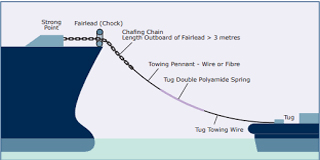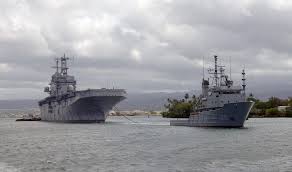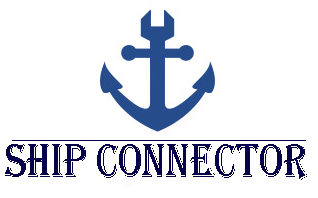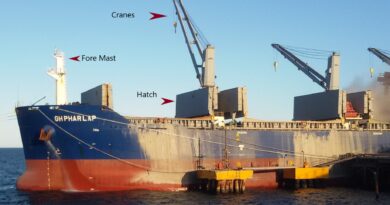Requirements of Fire Wires
Requirements of Fire Wires/Towing wire
In case of fire or explosion the ship is require to be towed away from the shore so as not to endanger the safety of port and other vessel tied on that berth.
Therefore the terminal require the provision of Fire wire / Towing wire, which are wire or generally called as mooring wires hanging over the side of the ship’s hull (off berth side of the ship)
In case of emergency tugs pull the ship away with the help of these mooring wire without the assistance of any ship’s crew.

Arrangements
One mooring wire in the forward/Bow and one at the aft/Stern of the ship are to be secured to the bitts with minimum five turns and a figure of eight no slack to be on board,the end of the mooring wire must have an eye to which a heaving line with monkey fist is tied.
The fire wire must always remain two metres above the water line so that tugs can reach to it without difficulty.
There are various methods in use for rigging emergency towing wires, and the arrangement may vary from port to port.
A terminal advise all ships which kind of method they use.
6 stranded rope 6*36 ws-iwrc
| Diameter [mm] | Diameter [mm] MBL (kN) @ 1770 N/mm2 | MBL (kN) @ 1960 N/mm2 | Weight (kg) per 100 meter |
| 8 | 37.4 | 41.4 | 22.5 |
| 9 | 47.3 | 52.4 | 28.5 |
| 10 | 58.4 | 64.7 | 35.2 |
| 11 | 70.7 | 78.3 | 42.6 |
| 12 | 84.1 | 93.1 | 50.7 |
| 13 | 98.7 | 109.0 | 59.5 |
| 14 | 114.0 | 127.0 | 69.0 |
| 15 | 131.0 | 145.0 | 79.2 |
Tensil strength: 1770N/mm2
1960 N/mm2
Wire ropes
Wire rope is made up of several strands of metal wire twisted together to form a a composite “rope”, the pattern formed by such a twist is also known as “laid rope”.
The wire ropes with Large diameter consists of multiple strands it is also known as “cable laid”.
Wire ropes are normally made of non-alloy carbon steel the carbon content in such ropes is 0.4 to 0.95%.

It is the high strength of the wire rope that enables to support large tensile forces and can run over sheaves .
Classified as two numbers (such as 6 x 19). The first number 6,represents number of strands in the rope. The second number represents the number of wires in each strand, For example- a 6 x 19 class wire rope will have six strands, but may have 15-26 wires in each strand.
4 common types of wire ropes:
- Single layer
- Seale
- Filler wire
- Warrington
Emergency towing arrangements for tankers
Emergency towing arrangements for tankers
As per SOLAS all oil tankers, chemical tankers and gas tankers of 20,000 tonnes or more in deadweight, are to be provided with an emergency towing provision in both ends of the ship(forward and aft).
The arrangements need to be simple with easy to use facilities.

The total time permitted to forward provision is 60 minutes while total time permitted for aft arrangement is 15 minutes only under bad weather and in total dark night conditions.
Forward towing arrangement- The pick-up gear and the towing pennant are made optional, but there is to be a strong point, a fairlead and a chafing chain.
Forward gears are usually installed in the centreline of the vessel.
Aft towing arrangement – Consist of pick-up gear, a towing pennant, chafing gear, a fairlead, a strong point and a roller pedestal.
The aft gear is often installed port or starboard side of the vessel but off the centre.
One important aspect of aft towing arrangement is pick-up gear can be released manually by one man only.
These provisions are tested for their strength by the concern authorities.
Towing strength for components
Tankers (20-50,000)tonnes DWT-1,000 kN
More than 50,000 Tonnes DWT- 2000 kN
The quality ought to be adequate for every important point of the towline, including a 90° draw to either side, and a 30° vertical force downwards.
This requirements not only to strengthen the vessel’s hull, but also at the fairlead point.
Towing pennant length
It is required to have a length of at least twice the lightest seagoing ballast freeboard at the fairlead, plus 50 metres.
When chain is used, it should be fixed to the strongest point and must reach at least three meters beyond the fairlead.
The crew are required to drop the pick-up gear overboard at the stern of the vessel before the vessel is abandoned.
Some vessel have only one buoy on the pick-up rope, others vessel use two, explaining that it is easy to get hold of a rope between two buoys, than the buoy itself.
The buoys should be fitted with a light to facilitate detection at night.
To read about marine fenders click here
Thanks for reading for:



